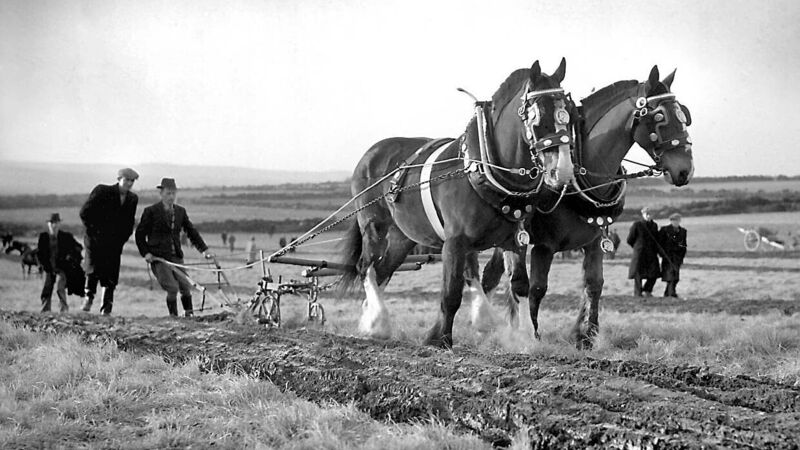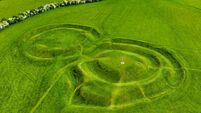John Arnold: I love hurling and ploughing, but alas, am useless at both!

Growing up in the early 1960s, I don’t recall much excitement about hurling around here.
Of course, I knew of Christy Ring, just finished with Cork and still playing away with Glen Rovers.
For a few of those years, we had no club team here in the parish. That changed in 1965 and in a few short years we were back with a Golden Era from 1965 until 1975.
My own family and relations would recall the great Jamesy Kelleher of Dungourney, who was married to my Auntie Ciss. A few times I met Larry Flaherty of Blackrock, who had hurled with Kelleher back in the first decade of the 1900s.
No-one can say who ‘invented’ ploughing but on very ancient cave drawings right across the world, depictions of primitive ploughing can be seen.
When our ancestors moved up in the world from being hunter gatherers to farmers who grew crops, they learned quickly about soil and fertility. They say roast pork was ‘invented’ in China when a piggery was burnt to the ground and all the pigs therein died in the calamity. A worker cleaning the debris burnt his finger on the remains of a completely incinerated pig. He thrust his finger in his mouth and got the flavour of pork - well, that’s the way the story goes anyway. Before long, piggeries were ‘accidentally’ being burned down all over the place!
Similarly, I suppose our agriculturalist forebears found some wild plant growing and noticed seeds on it. When dried, the seeds yielded a white powdery substance, and when wetted, it in turn made pastry, dough and bread. Soon, those early extensive Stone Age farmers realised that scattering the seeds on the ground and covering them with soil produced a crop for next year.
I suppose a man with a pointed wooden stick could claim to be the very first ploughman.
Soon, oxen and the horses were used to pull heavier wooden ploughs and the soil could be turned up in a better fashion to make a seed-bed.
Sixty years ago, we still had a working horse here on our farm, though we also had a tractor. I can’t say I remember seeing the horse ploughing but I do recall drills to grow potatoes, turnips and mangolds being opened, using the horse and the drill plough - that drill plough is still in the haggard, painted red and green now.
Padddy Geary, who worked for four decades with us, was of that generation that grew up with the working horse, but eventually moved on to master the art of driving the tractor and ploughing with it.
Back in the early 1970s, when I stayed at home on the farm, I was more interested in hurling than ploughing, and to be honest I was clean useless at both! From 1972 on, I started going to club and county games and thus started a passionate love affair that’s never dimmed.
Of course, I togged out at U14 level - we had no under U12 team at that stage. In fairness, I could throw the sliotar up in the air, but striking it before it hit the ground was a skill I never perfected. God knows, I tried hard, but my hand to eye coordination was woeful.
Oh, I played alright, well, a handful or two of matches over a seven or eight year period. To say I was awkward would be a compliment to my lack of hurling prowess. As the great Joe Dolan might say, I hurled ‘in my own peculiar way’.
Unfortunately, I was responsible for breaking a hand, a nose and a kneecap - and all those injuries I inflicted were on lads playing with me!
My lack of any natural ability, agility or skill never for one second dimmed my admiration for the game of hurling. There’s an old Moroccan maxim ‘You don’t have to be good at it to enjoy it’, and that’s still my Golden Rule.
We still had what was a typical mixed farm in the 1970s - cows, sheep, pigs, barley oats, malting barley, sugar beet, potatoes, turnips and mangolds so ploughing up to 20 acres annually was normal. We had a big Super Major tractor and a three furrow plough, so the ploughing, followed by the harrowing to break up the sods, was always a feature of spring work.
In fairness to Paddy, he tried his best to impart the skills of ploughing to me. I remember over in the Well Field he marked out different ‘lands’ or sections of the field with furze bushes off the ditches. He explained to me how to plough from bush to bush in a straight line. If I was there yet, I couldn’t make a fist of it.
To plough properly, one needs to set the plough to turn over sods at a certain depth, keep a straight line and ensure the sod is fully turned down. I never got the knack of it at all. I either let the plough down too deep and often got it caught in a whopper of a big stone, or else only scratched the surface.
Paddy had the patience of Job, Methuselah and Moses combined but he knew, and I knew, that I was never going to be a ploughman.
They say practice makes perfect -nearly always, but there are exceptions to every rule and in the case of ploughing I was a grave exception! ‘You’d break iron’, Paddy said to me one day after I had strained the main beam of the plough, and after that I gave up.
We don’t do much ploughing nowadays, except to re-seed a field maybe every second year. However, we plough half the Top Bog every year. It’s a funny shaped field - a bit like the shape of the continent of Africa.
I barely remember when the Top and Bottom Bogs were pure swamps. Drained in the mid 1960s, they are still very damp underneath with a wet whitish clay - great to grow grass of a dry year like last year.
With more than a decade now, we plough about two and a half acres of this field. You might say ‘we’re away with the birds’ and you’d not be far wrong at all!
We set a mixture of grain, flowers like poppy and a wide variety of seed bearing plants. No cows or other animals can graze this area.
The colourful display each autumn and winter is to provide food and cover for different wild birds during the October to March period.
Often, in the month of December of a fairly mild day, well, the Top Bog would be like an animal orchestra with humming, twittering and tweeting as birds, bees, butterflies, mice and voles all feasted. Martin, our ploughman, turned the green to brown last week. As he was ploughing it, I just loved to walk across the neatly covered sods as the seagulls and crows arrived for a worm-fest.
Stones are turned up, and on occasions one might find a rusty horseshoe or a broken piece of a cup or a plate - signs and reminders of those who tilled this land in days of yore.
After the sunshine of recent days, the purplish-white wet clay had dried out and a gentle breeze would rise dust there now. Today or tomorrow, we’ll set the bird seed mixture, give it a rub of a harrow, roll it, close the gate and wait for Mother Nature to do the rest.
When the ploughing was done last week, I walked up through Paircaliosa - it was used as a hurling pitch for the Carnival in the 1970s. Ah yes indeed, ploughing and hurling - ancient yet modern, some things never change.







 App?
App?




